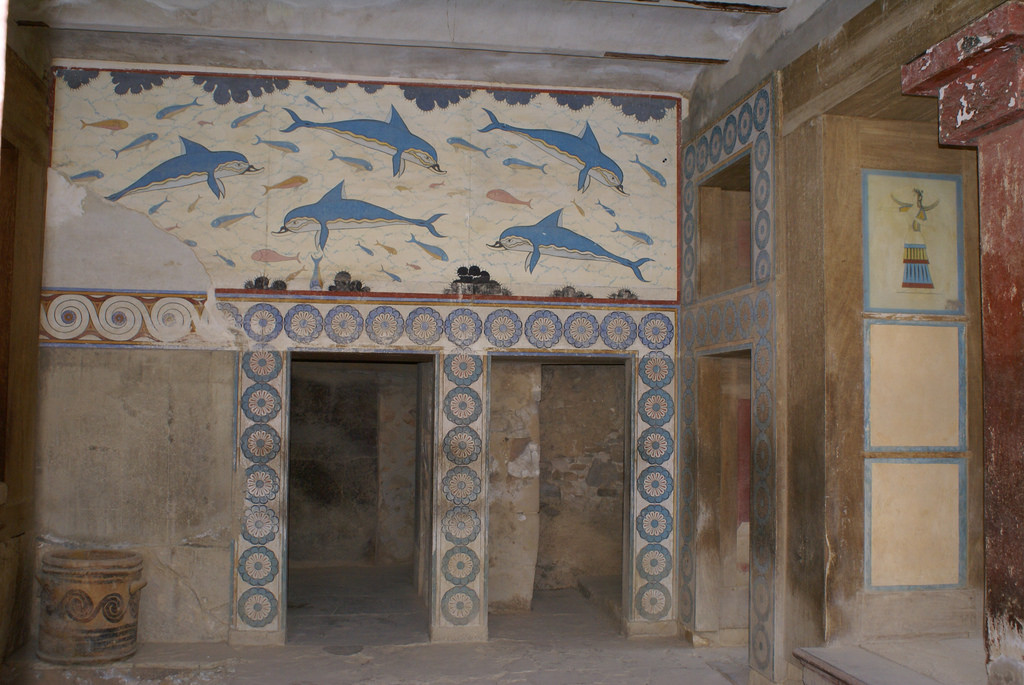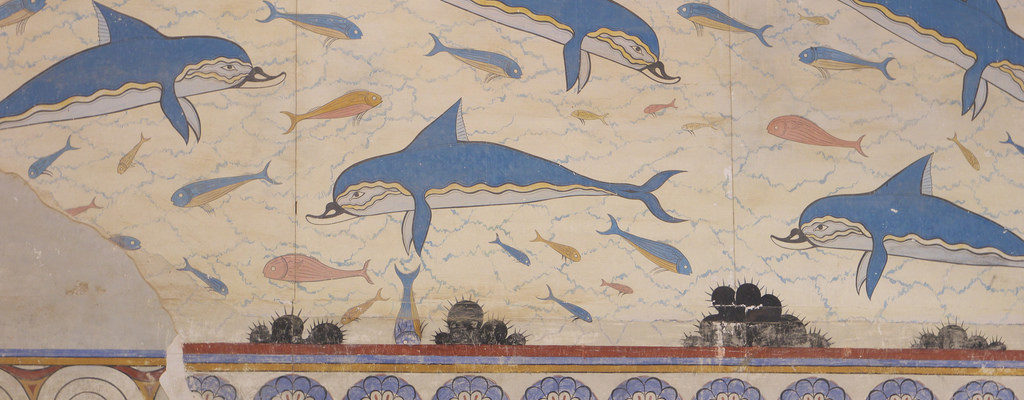The East Wing had four floors, which are not entirely visible from the Central Court. The Grand Staircase, which had a protective parapet of panels and was illuminated by a light-well, was the principle entrance to the East Apartments. The Staircase and a corridor lead to the Room of the Double Axes, named after the symbol incised on its walls, which for¬med part of the King’s Megaron.
Remains of an imposing throne made of gypsum were found in the room.
Two sets of doors-and-piers opened onto it from the east, with a room between them used for audiences. The doors-and ¬piers were closed with wood or fabric. A small door and a dog’s-leg corridor lead to the Queen’s Megaron. The room has a double window and a door leading into a covered area with two doors and two light-wells.
Fine frescoes were found in the Megaron, restorations of which are on the walls. The Dolphin fresco is on the north wall, and the “Dancer” fresco was found on a pilaster of the east set of doors-¬and-piers. West of the Megaron is the Queen’s Bathroom, with a sit-bath, and the Toilet Room with a low bench and a lavatory.
A door in the north wall of the Toilet Room leads into the Court of the Distaffs, called after the distaffs incised on the walls. In this courtyard and the lavatory one can see the wonderful plumbing system with cisterns and built drains.
The small room behind the lavatory was the Treasury, in which many precious objects of gold, ivory, faïence and jasper were found; the famous Ivory Bull-leaper was found here under a small stone staircase.
Other rooms in the area south of the King’s and the Queen’s Megarons that are worth visiting are the Shrine of the Double Axes, in which cult figurines of the Mycenaean period with their hands raised were found on a ledge.

© Photo credits by Richard Martin under CC-BY-2.0
Further south are private dwellings, like the Southeast House, where a metal fur¬nace was found, the House of the Sacred Chancel, the House of the Sacrificed Oxen, the House of the Fallen Blocks, all named after the finds in them. Outside the area of the site is the Minoan guest house, the Caravanserai, and further south again on the Knossos-Archanes road, the two-storey South Royal Tomb.
From the corridor that runs south of the King’s Megaron another corridor leads to the Lapidary’s Workshop, where many half-finished works were found. A room with benches to the north of this was called the Schoolroom, but it is more likely to have been a Potter’s Workshop.
Further north again, a door opens into the Court of the Stone Spout, which got its name from the long stone drain. The Toreador Fresco was found here. A little higher up is the Magazine of the Giant Pithoi, which contains the largest pithoi found to date; south of it is the Southeast Bastion.
Here you can see the drainage system beside the staircase. To the east, on the upper floor, is the large hall known as the East Hall. From this hall came the remains of a colossal wooden statue (it is estimated to have been 2.80 m high), whose bronze locks of hair have survived.
After the Magazine of the Giant Pithoi you come to the Corridor of the Draught-board, whose name comes from the royal game, a kind of chess-board made from ivory and other precious materials.
Further to the southwest is the Magazine of Medallion Pithoi.

Do you want to know more about Crete and the history of Greece?
Check out our guidebook to Ancient Greece, with detailed history and Past & Present images of the Acropolis, the Parthenon, Crete and all the greatest historical and archaeological sites of Ancient Greece.

